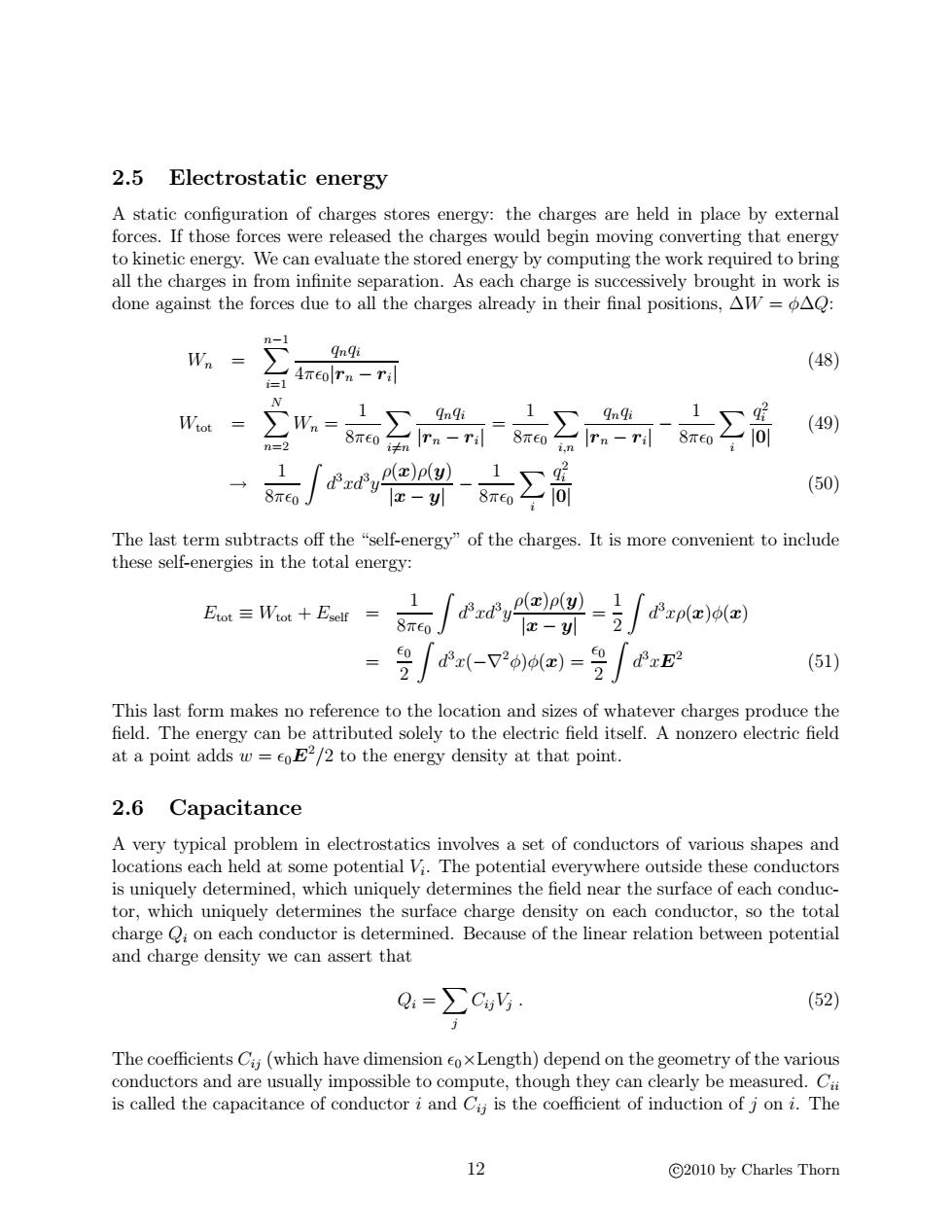正在加载图片...

2.5 Electrostatic energy A static configuration of charges stores energy:the charges are held in place by external forces.If those forces were released the charges would begin moving converting that energy to kinetic energy.We can evaluate the stored energy by computing the work required to bring all the charges in from infinite separation.As each charge is successively brought in work is done against the forces due to all the charges already in their final positions,AW =AQ: n-1 Wn gnqi (48) 4TeO Tn -Ti =1 Wtot ∑W= 1 gnqi 1 1 (49) n= 8r01 in lro-rdl 1 2-1∑ 8πe0 FryP()( (50) x-y The last term subtracts off the "self-energy"of the charges.It is more convenient to include these self-energies in the total energy: 1 Etot三Wtot+Esef p(c)p(y) = 8元e0 x-y 2 dxp(x)o(x) 2 dz(-V2o)o(x)= dxE2 (51) This last form makes no reference to the location and sizes of whatever charges produce the field.The energy can be attributed solely to the electric field itself.A nonzero electric field at a point adds w=eoE2/2 to the energy density at that point. 2.6 Capacitance A very typical problem in electrostatics involves a set of conductors of various shapes and locations each held at some potential Vi.The potential everywhere outside these conductors is uniquely determined,which uniquely determines the field near the surface of each conduc- tor,which uniquely determines the surface charge density on each conductor,so the total charge Qi on each conductor is determined.Because of the linear relation between potential and charge density we can assert that Q:=∑Cy (52) The coefficients Cii(which have dimension eoxLength)depend on the geometry of the various conductors and are usually impossible to compute,though they can clearly be measured.Ca is called the capacitance of conductor i and Cii is the coefficient of induction ofj on i.The 12 ©2010 by Charles Thorn2.5 Electrostatic energy A static configuration of charges stores energy: the charges are held in place by external forces. If those forces were released the charges would begin moving converting that energy to kinetic energy. We can evaluate the stored energy by computing the work required to bring all the charges in from infinite separation. As each charge is successively brought in work is done against the forces due to all the charges already in their final positions, ∆W = φ∆Q: Wn = Xn−1 i=1 qnqi 4π0|rn − ri | (48) Wtot = X N n=2 Wn = 1 8π0 X i6=n qnqi |rn − ri | = 1 8π0 X i,n qnqi |rn − ri | − 1 8π0 X i q 2 i |0| (49) → 1 8π0 Z d 3xd3 y ρ(x)ρ(y) |x − y| − 1 8π0 X i q 2 i |0| (50) The last term subtracts off the “self-energy” of the charges. It is more convenient to include these self-energies in the total energy: Etot ≡ Wtot + Eself = 1 8π0 Z d 3 xd3 y ρ(x)ρ(y) |x − y| = 1 2 Z d 3 xρ(x)φ(x) = 0 2 Z d 3 x(−∇2φ)φ(x) = 0 2 Z d 3 xE 2 (51) This last form makes no reference to the location and sizes of whatever charges produce the field. The energy can be attributed solely to the electric field itself. A nonzero electric field at a point adds w = 0E 2 /2 to the energy density at that point. 2.6 Capacitance A very typical problem in electrostatics involves a set of conductors of various shapes and locations each held at some potential Vi . The potential everywhere outside these conductors is uniquely determined, which uniquely determines the field near the surface of each conductor, which uniquely determines the surface charge density on each conductor, so the total charge Qi on each conductor is determined. Because of the linear relation between potential and charge density we can assert that Qi = X j CijVj . (52) The coefficients Cij (which have dimension 0×Length) depend on the geometry of the various conductors and are usually impossible to compute, though they can clearly be measured. Cii is called the capacitance of conductor i and Cij is the coefficient of induction of j on i. The 12 c 2010 by Charles Thorn